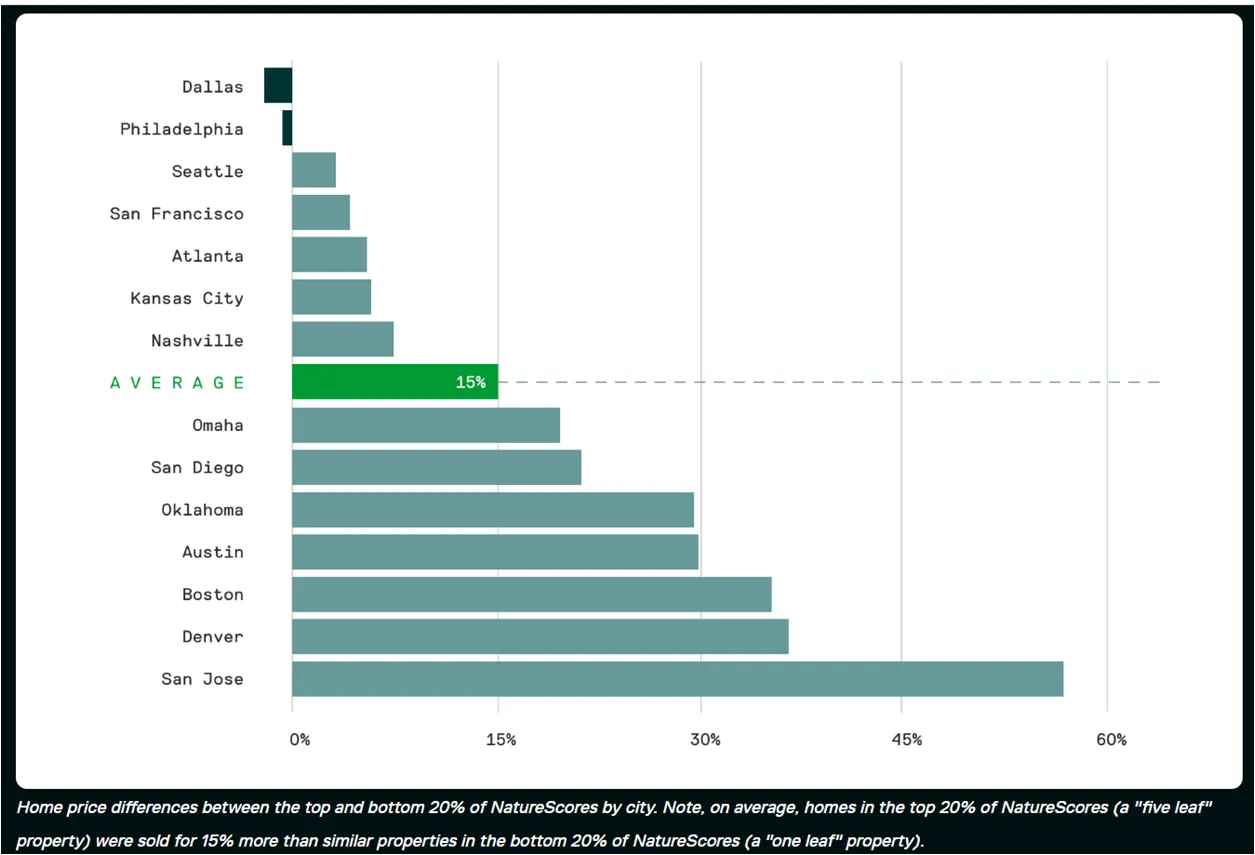Nature and Real Estate
A new real estate technology is now available to determine the amount and quality of near-by nature.

Key Points
- A new and powerful tool is now available that adds a unique dimension to real estate analysis: a way to measure nearby nature.
- NatureQuant’s “NatureScore®” merges aerial imagery analysis, satellite infrared measurements, land and vegetation databases, computer vision, and various map and GIS parsing tools to deliver a single comprehensive nature measurement score. Additionally, the NatureScore® considers built environmental pollutions, like air quality, noise pollution, “urban heat islands”, and light pollution.
- While the elements in the NatureScore® were blended via a machine learning system to predict positive health outcomes (reductions in cancer, diabetes, heart disease, obesity, etc.), the NatureScore® was also found to be associated with real estate price premiums.
Real Estate
When picking a home, it is common to screen by the number of bedrooms or bathrooms, but what if, all else being equal, you wanted a house on a street with big trees, or near lots of parks or lakes, or in a neighborhood with lots of lush landscaping? There is now a technology tool to help you determine the amount of nature near any piece of real estate: a NatureScore®.
It is clear that trees and other vegetation around a home add not only aesthetic appeal but also can provide shade during the summer and wind protection in the winter. Further, they can offer visual privacy and mitigate sound.
What is less known, but becoming equally clear, is that living in greener urban areas is associated with lower probabilities of cardiovascular disease, obesity, diabetes, asthma hospitalization, mental distress, and ultimately mortality among adults, and with lower risks of obesity and myopia in children. Nature-rich neighborhoods are also associated with better self-reported health and subjective well-being in adults, and with improved birth outcomes and cognitive development in children. Nature spaces may also reduce the transmission rate of contagious diseases (like COVID-19). Specifically, a recent meta-study involving eight-million people and seven countries found that for every 10% increase in vegetation within 1,600 feet of one’s home, the probability of death drops by 4%.
Natural areas also have been linked to other positive effects, like lower pollution and reduced crime rates.
As these results shape the public mindset, natural areas will increasingly impact real estate value and design. By way of example, a study in Toronto, Canada concluded that living in a home with ten or more trees in a city block, on average, improves health perception as much as earning $10,000 more per year or being seven years younger. Proprietary research using the NatureScore® techniques and home sales in 2019 has shown up to 50% increases in property values (see chart below) for some regions. We are already seeing an increased desire for more open and natural spaces with the mass migration away from cities in response to the COVID-19 pandemic.

While the advantages of living in a greener area are clear for a place of residence, businesses are also taking note. Many businesses are recognizing that health is material to the bottom line: Research shows that when organizations support the health of their most valuable assets (the people), they often experience lower turnover and burnout as well as greater productivity and employee engagement. Amazon’s “Nature Spheres” are a great example of a corporation leveraging the benefits of nature, but simple things like desk plants or even a natural landscape "screen-saver" have proven to have a positive impact.
Furthermore, health is currently underrepresented in the capital markets. While the investment community has historically failed to acknowledge the materiality of health to organizations, it is increasingly becoming recognized as an important component of sustainable investing frameworks like ESG - the environmental, social and governance framework of corporate responsibility.
The correlations between property value, health, and NatureScores could also be used to assess real estate portfolios, mortgage-backed securities, mortgage lender risks, insurance risks, pension plan liabilities, city planning priorities, and tax assessor models (averaging the market effect of street trees on all house values across a major urban population can yield a total value increase of billions, which translates into potentially higher property tax revenues for the cities managing the trees).
Great advances in public health do not always come from the healthcare industry. They often come from the recognition of elements of our environment that are detrimental or beneficial to our well-being, like smoking, exercise, or diet. Nature exposure is next, and the NatureScore® technology can help guide the way to a healthier future. NatureScore® should be a basic component of any real estate assessment.